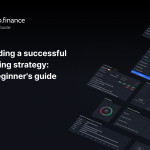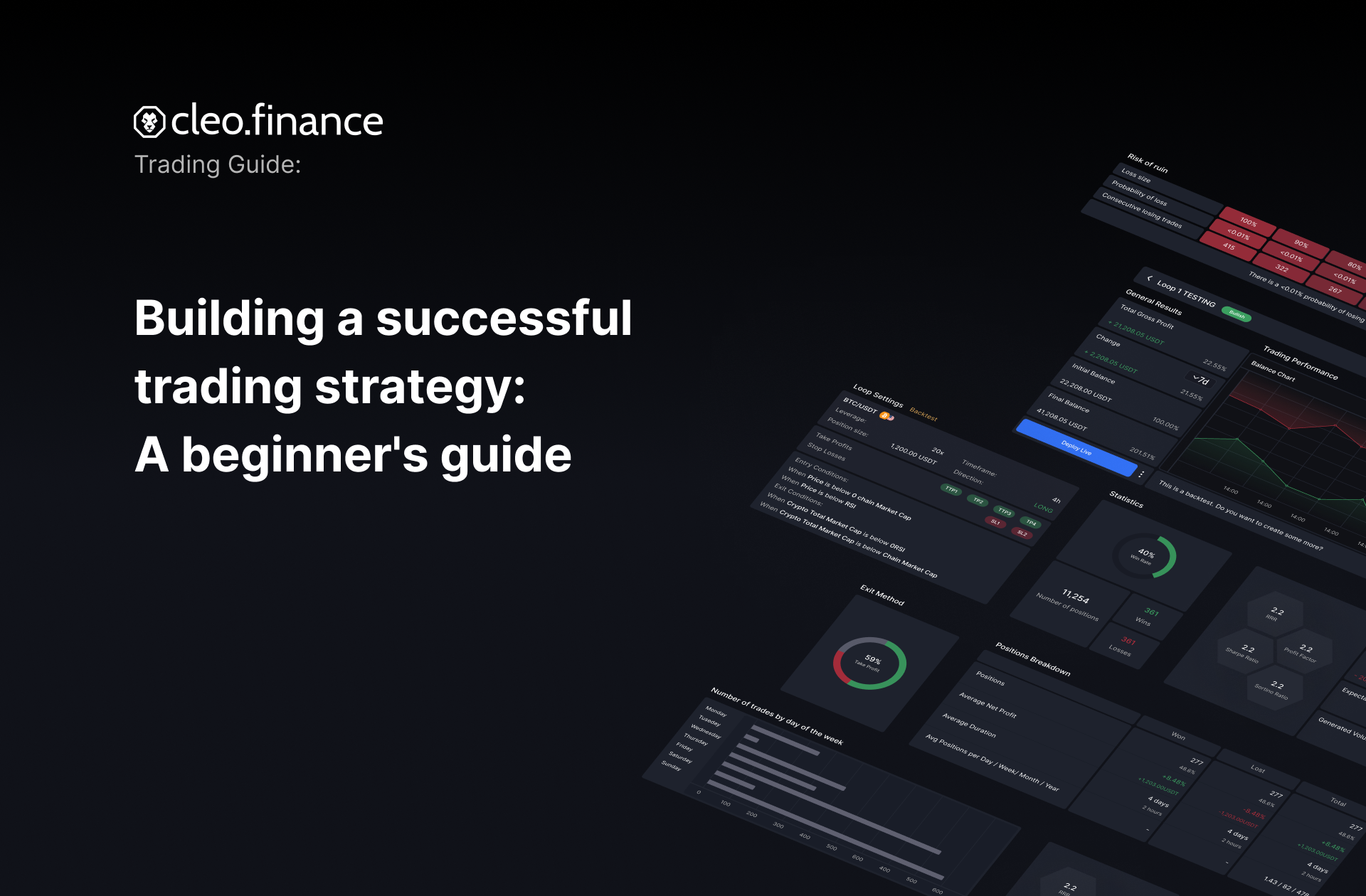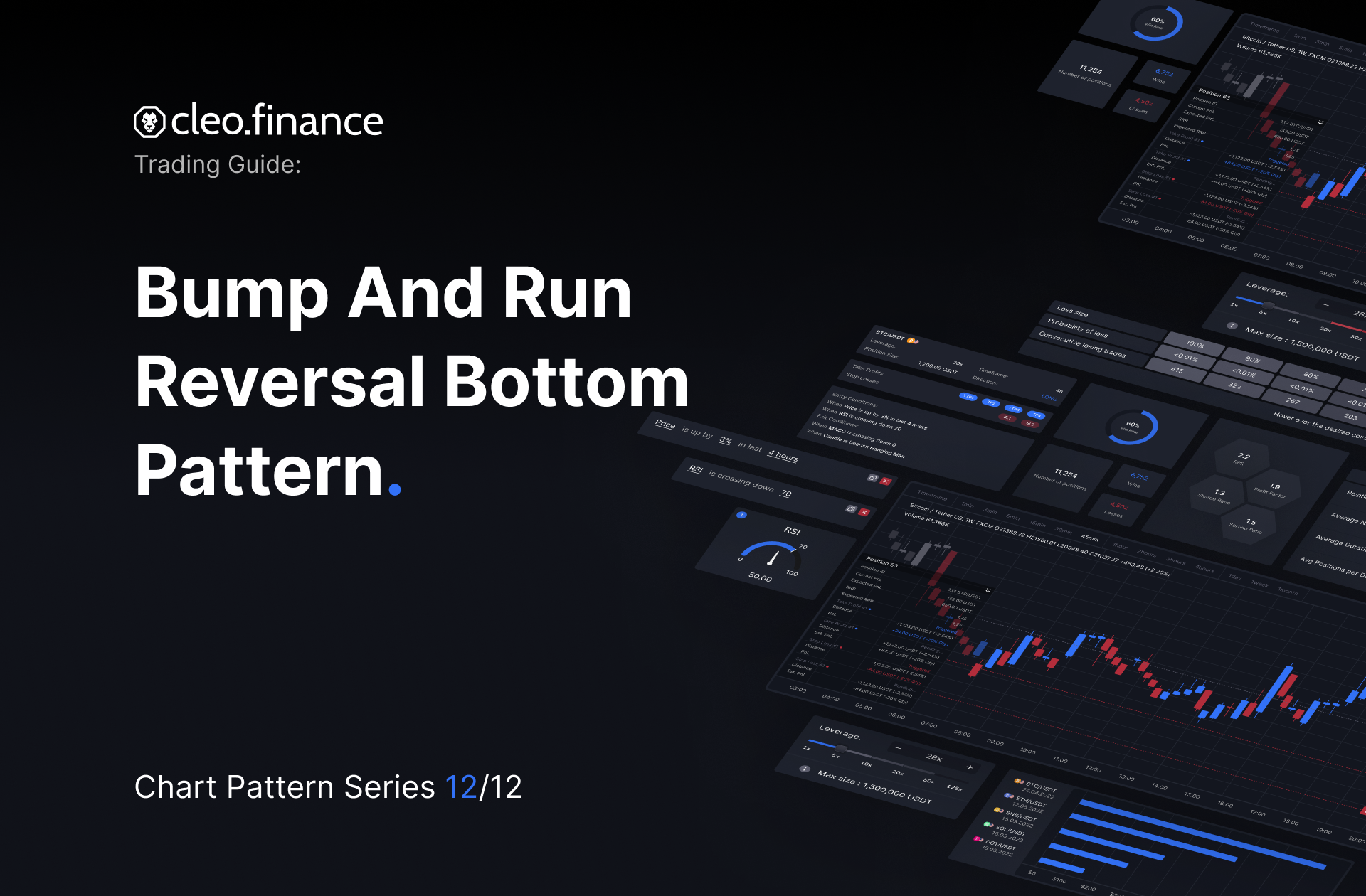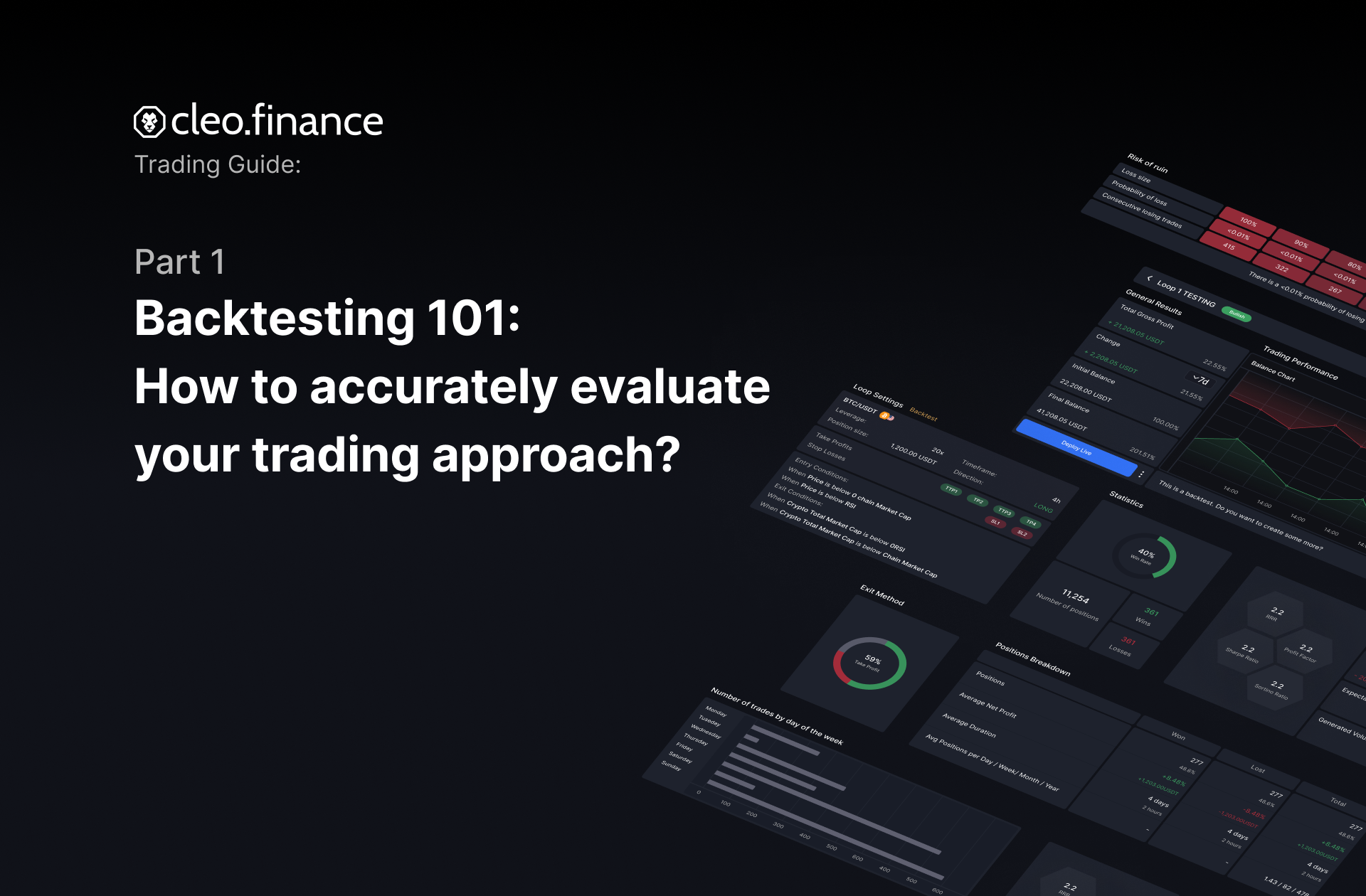Building a successful trading strategy: A beginner’s guide11 min read
A trading strategy is a set of rules and guidelines that defines a trader’s approach to the market. It includes the specific filters, indicators, and signals that the trader uses to identify trading opportunities, as well as the rules for entry, exit, and risk management. A well-defined trading strategy can help traders to approach the market in a systematic and disciplined way, increasing chances of success.
In many articles, the terms system, trading approach, and strategy are used interchangeably to refer to a set of rules and guidelines that define a trader’s approach to the market. While I understand the desire for simplification, I consider these terms to have slightly different meanings. In the simplest sense, they all refer to a systematic and disciplined approach to trading.
In a more detail-oriented way of thinking, strategy means a set of specific trading and risk management rules, whereas a trading system can be a set of such strategies all used in different ways, and also general portfolio-related strategies, such as diversification, rules for adjusting per asset/market exposure, but also importantly motivation statements, monthly/yearly goals, daily/weekly routine overviews, broader money management rules etc. In this article, we will focus solely on a general process of defining a specific trading strategy.
You can find trading strategy examples here.
We post results using those strategies on Bitcoin and forex trading strategies like Judas Swing on @cleofinance every week.
Table of Contents
Why do I need a trading strategy?
It doesn’t matter if you’re trading forex, crypto, stocks or indices. Creating a trading strategy is like plotting a course on a map before setting sail. Just as a sailor needs a map to guide them to their destination, a trader needs a well-defined strategy to guide their approach to the market. A trading strategy provides a roadmap for decision-making, helping traders to navigate the complexities of the market and avoid potential pitfalls.
Without a trading strategy, a trader is like a sailor without a map or a destination. They may set out to sea with enthusiasm, but they are likely to encounter challenges and obstacles along the way. Without a clear plan or direction, they may make impulsive or emotional decisions that put their capital at risk.
On the other hand, a trader with a well-defined trading strategy is like a sailor with a detailed map and a clear destination. They have a structured and disciplined approach to the market, and they are able to make informed and consistent decisions based on their strategy’s rules and guidelines. This allows them to navigate the market effectively, increasing their chances of success and maximizing their potential profits.
If you’re reading this you’ve probably heard that 90 % (or some other horrific percentage) of all retail traders lose money. I’d argue that the root cause of the majority of these losing accounts is an undisciplined approach to the trading process. Most traders don’t fail at trading because it is hard. They fail because they are not willing to put in the work to create a detailed plan, test the plan, and then follow the plan.
What is the most important goal of a trading strategy?
You’re continuing to read this article. That means that you want to become a sailor and don’t get seasick on the regular. Good.
The most important goal is to develop a strategy with positive expectancy. In other words, a trading strategy should have a higher probability of making a profit than a loss. Searching for a successful trading strategy can be a time-consuming process, but it is essential for turning trading into a reliable source of income.
Without a well-researched and tested strategy, trading can feel like gambling, with unpredictable and potentially costly results. By taking the time to carefully search for and implement a reliable trading strategy, you can increase your chances of success and make your trading more consistent and profitable. In other words: You should not enter the competitive world of financial markets unless you have a trading strategy that produces positive expectancy!
To determine whether a trading strategy has a positive expectancy, there are three key factors to consider:
- Win rate
- Risk-reward ratio (RRR)
- Transaction costs
The win rate refers to the percentage of trades that are profitable, while the RRR is the ratio of the average potential profit to the average potential loss on a trade. Transaction costs include commissions, fees, and other expenses associated with executing a trade.
Example:
- Trades: 100
- Win rate: 50%
- RRR: 1:2
- Transaction costs in total: 5% of balance for the 100 trades
Expectancy = (Win rate x Win Size) – (Loss rate x Loss size) – TC = Expectancy per trade
Expectancy = (0,5 x 2) – (0,5 x 1) – 0,05 = 0,45 R per trade
Over the course of hundred trades, you would win half of them (50). But because you can win twice as much as you’re risking (1:2 RRR), throughout the 100 trades you would on average win half of what you’re risking (avg. profit of 0,5R). If you deduct the transaction costs, this comes down to 0,45R of profit for every open position.
If you risked 100 USD per trade (R = 100 USD), on average you could expect to win 45 USD for every trade you open.
By considering these three factors together, you can determine whether a trading strategy has a positive expectancy and is likely to be profitable over the long term. There are other calculations for expectancy, dependent on what data you have available and if you’re interested in monetary value (PnL) or R multiplier like I did, but the information value is the same.
Where to start when defining your trading strategy?
1. Define your trading approach
Do you want to develop a mean reversion strategy, which aims to profit from buying low and selling high in a range-bound market? Or are you more interested in a trend-following strategy, which seeks to capitalize on the momentum of a trending market?
Some traders may use a single strategy for all market conditions, while others may adapt their approach based on the market type. For example, a trader may use a mean reversion strategy in a ranging market and a trend-following strategy in a trending market. It is the obvious goal to become a swiss knife of a trader, but for starters, pick one. One you will feel more comfortable with executing.
2. Consider your trading style
Once you’ve decided on the type of strategy you want to build, you need to think about your trading style. Do you want to use a discretionary approach, where you make trading decisions based on your own analysis and judgment? Or do you prefer a systematic approach, where you use a set of pre-defined rules and algorithms to make your trades?
As a general rule, newcomers should try to approach trading as systematically as possible. There can be some discretionary variations within the system, but the less room for emotional or “on-the-spot” decisions you have, the better. Discretion is ultimately the experience you have and as a new trader, you don’t have any. I’d also go as far as to say that the best discretionary traders started with a very mechanical systematic trading strategy. Only with time, they learned to identify stronger and weaker opportunities within their system, which made them interfere with the strategy and ultimately trade discretionarily.
3. Select a trading frequency that fits you
Now consider how much time you want to invest in trading, and how often you want to make trading decisions. This should help you determine the type of trading you want to pursue.
Scalping is a type of trading that involves taking small profits on a frequent basis. Scalpers typically open and close their positions within minutes or even seconds, aiming to capitalize on small price movements. Scalping can be a high-stress and high-risk approach, but it can also be very profitable if done correctly. Scalpers generally execute their trades on very low timeframes.
Intraday trading, also known as day trading, involves opening and closing positions within the same trading day. Intraday traders typically hold their positions for a few hours or less and aim to profit from short-term price movements.
Swing trading is a longer-term approach that involves holding positions for a few days or weeks. Swing traders aim to capitalize on the price swings that occur over this time frame, and may use technical analysis to identify entry and exit points.
Buy-and-hold investing, also known as long-term investing, involves buying assets with the intention of holding them for a long period of time, often years or even decades. Buy-and-hold investors aim to benefit from the long-term growth potential of their investments and may use fundamental analysis to identify attractive opportunities.
A key concept to bear in mind is that although the price is fractals (meaning, you will see the same structures on all timeframes), the lower timeframe charts can be more “noisy”. This can make it harder to see clear patterns and trends in the market and makes them less reliable for deriving trading decisions from the price curve. In general, higher timeframe charts are considered to be more reliable because they show a longer period of data and can provide a clearer picture of the market’s overall trend.
Overall, these four most popular trading approaches for individual traders – scalping, intraday trading, swing trading, and buy-and-hold investing – each have their own characteristics and potential benefits. The right approach for you will depend on your trading goals, risk tolerance, and other factors.
If you are most interested in investing, there are many other sites focused on producing content specifically for this type of financial activity. Cleo.finance is a tool for traders, and although long-term investing and testing using it is also possible, the platform wasn’t made for it.
4. Consider asset class and indicators
This is the final stage of the basic decision matrix every trader has to go through before creating a new trading strategy. At this phase you might want to choose an asset class to focus on and what kind of information you will take into consideration. The most popular trading asset classes are stocks, cryptocurrencies, currencies (FX), commodities, and indices. The foundation for trading decisions can be fundamental analysis and technical analysis. Lately, we can distinguish a third segment of the trading category: sentiment analysis, a social media narrative-driven decision process.
Putting it all together
At this point, you should be able to verbalize the strategy you’re looking to build and the reasoning behind it.

Not all of these categories work perfectly together. Some strategies can be easily applied to any assets and any trading frequency, while some strategies can be exploiting very asset-specific inefficiency (such as seasonality in commodities trading, or price cycles with bitcoin halving) or rely on infrequent information which makes it hard to be applied to scalping trading style.
Also, very important to lean into what works for you specifically. A lot of times I see traders trying to bend over backward to fit into some idea of what a trading strategy should be. Lean into your strengths. If you can draw insights from analyzing cross currency pairs then do it. If you want to scalp, but don’t have the time, the patience, or the competency to do so, stop pursuing it. Luckily, trading will make you quickly notice a dead-end approach.
Backtesting your forex, crypto or stocks trading strategy
Once you chose an approach that fits you, don’t waste time on guessing if it will work. Backtest a few variations and see if it has potential. Many traders get lost at this step or don’t do it at all.
Automated Backtesting is when you set strategy rules and see how it would perform on historical data – great for seeing what is worth investigating better.
Manual Backtesting is when you simulate your trading using market replay. Ideal for practicing execution and doing a deep dive on market conditions.
Conclusion
The hope for this article was to lay down general rules and pointers on how to go about designing your trading strategy. If you focus on designing a strategy that fits you and has positive expectancy, you should be able to improve your chances of survival in financial markets.
In the next article, we will look in detail at the components of each trading strategy – the entry and exit conditions and risk management – aka the juicy part. Continue your journey by reading an article about setting stop-losses to protect against potential losses, and determining the appropriate position size based on the amount of risk being taken. Good luck!





